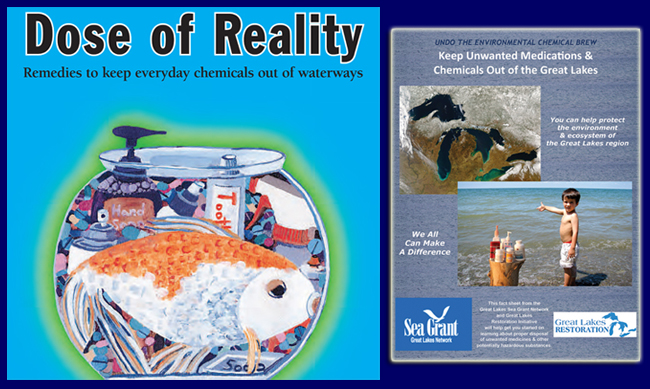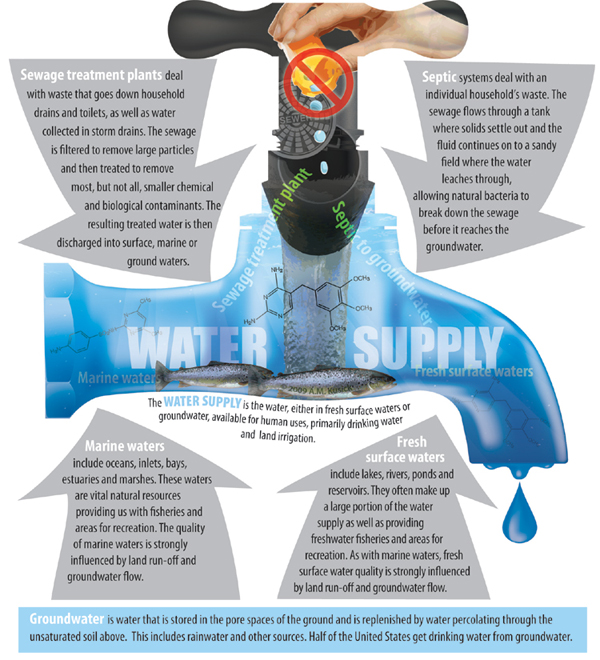Contact:
Helen Domske, NY Sea Grant's Coastal Education Specialist, P: 716.645.3610, E: hmd4@cornell.edu
Katherine Bunting-Howarth, New York Sea Grant Associate Director, Cornell University, E: keb264@cornell.edu, P: 607-255-2832
Buffalo, NY, April 25, 2017 - Twice a year New York residents can take
their unused pharmaceuticals back to collection sites statewide. Why
they should do so is highlighted in the ‘Undo the Environmental Chemical Brew: Keep Unwanted Medications and Chemicals Out of the Great Lakes’ guide developed by New York Sea Grant. The guide is posted online at www.nyseagrant.org/unwantedmeds.
The guide written by New York Sea Grant Coastal Education Specialist Helen Domske,
associate director of the Great Lakes Program at the University of
Buffalo, Buffalo, NY, includes tips on how citizens can keep unwanted
pharmaceuticals and personal care products, also called PPCPs, out of
local waters and out of the Great Lakes system.
"Taking unused prescription drugs to collection sites helps reduce the
impact of unwanted substances on the water resource that provides
drinking water to 42 million people in the United States and Canada and
aquatic habitat for a host of fishes and other wildlife," Domske said.
The Undo the Chemical Brew guide lists 17 different types of PPCPs,
including antibiotics, hormones, contraceptives, antidepressants,
cosmetics, and vitamins, that are finding their way into the Great
Lakes, the source of drinking water for 42 million people in the United
States and Canada.

The Undo the Environmental Chemical Brew guide from New York Sea Grant
(above, at right) encourages Drug Take Back participation and proper
disposal of unwanted pharmaceuticals and personal care products to
protect Great Lakes waters. It is part of a larger campaign produced by
the Great Lakes Sea Grant network, which NYSG is a member.
Research by New York Sea Grant and other science organizations has
tracked the feminization of fish populations downstream from wastewater
treatment plants to estrogen and its components found in prescription
drugs.
"Researchers are increasingly documenting the impact of bioactive
chemical substances in PPCPs throughout the aquatic food web on fishes,
frogs, mussels and other freshwater organisms. We do not want people
flushing unwanted and unused medicines down the toilet or drain," Domske
said.
A New York Sea Grant-funded, two-year research project that began in
February 2016 is examining the effectiveness of advanced water treatment
options, environmental levels and potential effects of pharmaceuticals
in New York waters.
What You Can Do
The biannual National Prescription Drug Take Back Days are an initiative
of the U.S. Drug Enforcement Agency in cooperation with law enforcement
agencies nationwide. Authorized collection sites are posted online via
the U.S. DEA National Take Back Day Initiative Web site. Collection hours are 10am to 2pm on Saturday, April 29, 2017.
During last spring's Take-Back Day, the DEA reports that Americans turned in more unused prescription drugs than on any of the previous 10 events since it began in 2010, demonstrating their understanding of the value of this service. Some 893,498 pounds of unwanted medicines—about 447 tons—were collected by the DEA and over 4,200 of its state, local, and tribal law enforcement partners at almost 5,400 sites spread through all 50 states.
The U.S Food and Drug Administration provides a comprehensive list of drugs that it recommends for disposal via the sink or toilet.
In addition to Sea Grant's "Return Unwanted Medicines" resources, our program offers a number of other "Green Tips for Coastal Living."
On Air: Drug Take Back Day helps protect fish in Great Lakes (WBFO Radio)
This audio clip is from a discussion on WBFO radio. Based in Buffalo NY, WBFO 88.3 FM is a part of the National Public Radio digital network. If you don't see the player above, it's because you're using a non-Flash device (eg, iPhone or iPad). You can download the mp3 file by clicking here (mp3). It may take a few minutes to download, so please be patient.
April 28, 2017 - By Angelica A. Morrison
National Prescription Drug Take Back Day takes place Saturday, April 29, and New York Sea Grant is urging residents of the Great Lakes region to participate to help protect fish and wildlife. The organization says fish downstream from wastewater plants sometimes contain chemicals like estrogen from prescription drugs.
"It goes into our waterways if you flush these chemicals into our waterways they're going to stay in our waterways," said Kathy Bunting-Howarth, associate director for New York Sea Grant.
The event gives residents a chance to take unused pharmaceuticals to collection sites as an alternative to flushing them down the toilet, she said.
A second National Take Back Day is scheduled for Sept. 29.
Bunting-Howarth says that on days when the take back program isn't offered, folks may be able to take unused drugs to a local pharmacy.

When pharmaceuticals are flushed, they enter household septic systems or
sewage treatment plants and can make their way into our waterways or
even water supply. Follow the diagram to see how. Information courtesy
of Stony Brook University (SBU) School of Marine and Atmospheric
Sciences researcher Dr. Henry Bokuniewicz and SBU graduate student Ruth
Coffey. Illustration by Anita Kusick.
More Info: New York Sea Grant
New York Sea Grant (NYSG), a cooperative program of Cornell University
and the State University of New York, is one of 33 university-based
programs under the National Sea Grant College Program (NSGCP) of the
National Oceanic and Atmospheric Administration (NOAA). The NSGCP
engages this network of the nation’s top universities in conducting
scientific research, education, training and extension projects designed
to foster science-based decisions about the use and conservation of our
aquatic resources. Through its statewide network of integrated
services, NYSG has been promoting coastal vitality, environmental
sustainability, and citizen awareness about the State’s marine and Great
Lakes resources since 1971.
New York Sea Grant maintains Great Lakes offices at SUNY Buffalo, the
Wayne County Cooperative Extension office in Newark and at SUNY Oswego.
In the State's marine waters, NYSG has offices at Stony Brook University
and Stony Brook Manhattan, in the Hudson Valley through Cooperative
Extension in Kingston and at Brooklyn College.
For updates on Sea Grant activities: www.nyseagrant.org has RSS, Facebook, Twitter, and YouTube links. NYSG produces a monthly e-newsletter, "NOAA Sea Grant's Social Media Review," via its blog, www.nyseagrant.org/blog. Our program also offers a free e-list sign up via www.nyseagrant.org/coastlines for its flagship publication, NY Coastlines/Currents, which is published 1-2 times a year.